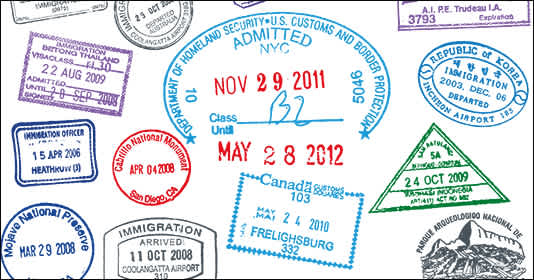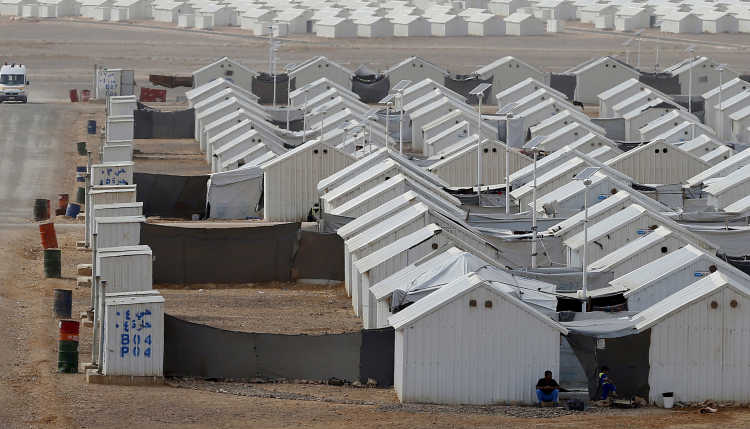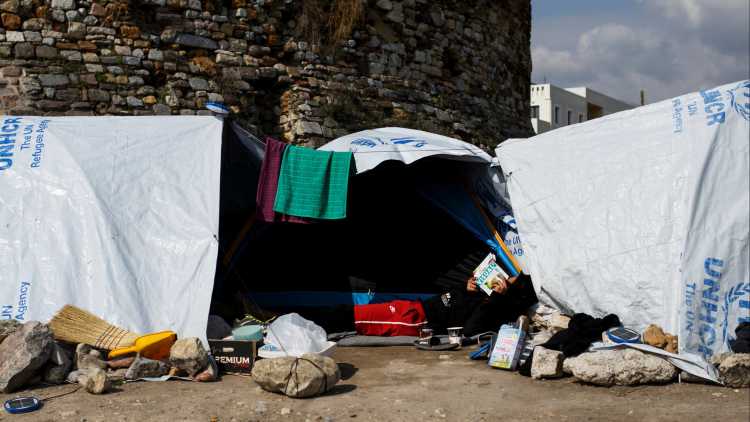- Startseite
- Publikationen
- GIGA Focus
- Perceiving Migration Crises: A View from the European Neighbourhood
GIGA Focus Nahost
Europäische Migrationskrisen aus tunesischer und türkischer Sicht
Nummer 5 | 2020 | ISSN: 1862-3611

Die in der EU dominante Wahrnehmung von Migration als „Krise“ ist ausgesprochen eurozentrisch, da Migrationsbewegungen in Richtung der EU im Vergleich zu Migration innerhalb anderer Weltregionen relativ unbedeutend sind. Wie beurteilen dagegen zentrale Aufnahmestaaten wie Tunesien und die Türkei, die politisch an die EU gebunden sind, Migrationsbewegungen, die innerhalb der EU als „kritisch“ diskutiert werden? Wie schätzen sie die sich daraus ergebenden Migrationsabkommen ein?
Die in den tunesische Medien zum EU-Migrationsabkommen vom Juni 2018 geführten Debatten verdeutlichen, dass die „Migrationskrise“ als ein von politischen Akteuren in der EU zum eigenen politischen Vorteil konstruierter Diskurs erkannt worden ist. Trotz einer hohen und steigenden Zahl von Flüchtlingen wurde in Tunesien selbst – zumindest in den Medien – zu diesem Zeitpunkt keine solche „Krise“ diagnostiziert. Stattdessen stand die Berichterstattung mit Bezug auf lokale und innenpolitische Krisen sowie die tunesische Vermittlerrolle im benachbarten libyischen Konflikt im Vordergrund.
In ähnlicher Weise zeigt die analysierte türkische Berichterstattung über die Verhandlungen im Vorfeld des EU-Türkei-Abkommens vom März 2016 ein Bewusstsein für die innnerhalb der EU erfolgte Konstruktion einer „Migrationskrise“. Trotz der rasanten Entwicklung der Türkei von einem Emigrationsland zu einem der wichtigsten Aufnahmeländer für Flüchtlinge weltweit konzentrierte sich die türkische Medienberichterstattung überwiegend auf innenpolitische Themenfelder und die strategischen Interessen der Türkei im Syrienkonflikt.
Die europäische Wahrnehmung von Migration als krisenhaftes Phänomen und die Diskrepanz zwischen dem rhetorischen Bekenntnis der EU zu humanitären Werten und demgegenüber ihrem realen politischen Handeln werden in der europäischen Nachbarschaft sowohl aufmerksam verfolgt als auch kritisch bewertet. Daher ist es notwendig, in Zukunft besser zu verstehen, wie die EU von außen wahrgenommen wird, weil dies entscheidende Auswirkungen auf die zukünftige nachbarschaftliche Zusammenarbeit haben kann.
Fazit
Die EU muss sich lokaler und nationaler Diskurse über Migration in den (potenziellen) Partnerstaaten in ihrer Nachbarschaft bewusst sein und darüber reflektieren, welche Akteure innerhalb und außerhalb Europas von einer Darstellung von Migration als „Krise“ profitieren. Zudem gilt es bei der Aushandlung gemeinsamer Migrationspolitik zwischen der EU und deren Nachbarstaaten, die schwerwiegenden legalen Schutzlücken für Flüchtlinge und Migranten in Partnerstaaten anzusprechen.
“Migration Crises” in the European Neighbourhood?
European discourses on (im)migration have been dominated by a crisis narrative in recent years. In February 2016, for instance, Donald Tusk, then president of the European Council, called the arrival of several hundred thousand refugees to the European Union “the greatest migration crisis in the history of Europe” (The European Council 2016). In particular, so-called “mixed” migration – when people are leaving for a mixture of reasons, including political, ecological, and economic ones – has led to the widespread perception across Europe that the immigration of large numbers of non-EU citizens needs to be perceived as “critical.” Given that the vast majority of people in these migration movements have stayed within the Global South, this perception is extremely biased and Eurocentric. But how have these developments in migration been perceived in the Maghreb and the Middle East, especially in countries of first asylum such as Tunisia and Turkey? How are the European “migration crises” being discussed in those two countries? Analysing the discussions and negotiations around two major European migration deals in recent years as case studies – first, the establishment of “disembarkation platforms” in North Africa and the Sahel (2018) and, second, the EU–Turkey deal (2016) – we explore the meaning that media discourses in Tunisia and Turkey have assigned to European migration deals during key moments of European migration crises by examining leading newspapers of different political orientations.
We conducted a qualitative media analysis of the reporting of these deals in three outlets for Turkey, Cumhuriyet, Milliyet, and Sabah, and four for Tunisia, Al Chorouk, La Presse de Tunisie, La Jeune Afrique, and Inkyfada. Cumhuriyet was the most prominent opposition voice in the Turkish mediascape until September 2018, when its leadership changed. Milliyet is considered government-friendly and is located in the middle ground between quality press and tabloid. Sabah is Turkey’s most widely circulated newspaper, is considered pro-government, and publishes in Turkish, English, and German. Al Chourouk, Tunisia’s first daily in Arabic in tabloid format, had a pro-government and pan-Arab slant during Ben Ali’s presidency. La Presse de Tunisie, the country’s first daily in French, similarly followed a pro-government line before 2011 and experienced an opening post-2011. La Jeune Afrique, a French pan-African weekly magazine, focuses on the Maghreb and francophone Africa. It was banned several times in Tunisia. Finally, Inkyfada, an online bilingual webzine in French and Arabic, was founded after 2011 with the objective of establishing slow journalism in Tunisia. For Turkey, we studied the front pages from 15 to 18 October 2015 (from the decision on the EU–Turkey Joint Action Plan to a subsequent meeting between Ahmet Davutoğlu and Angela Merkel), 24 November 2015 (EU–Turkey Joint Action Plan for the EU–Turkey Statement), and from 8 February to 18 March 2016 (starting from leaked minutes of a meeting between Recep Tayyip Erdoğan, Jean-Claude Juncker, and Donald Tusk and leading up to the actual EU–Turkey Statement), as well as 55 other articles in/on these outlets on these topics. For Tunisia, we studied the front pages from 11 to 14 November 2015 (Valletta Summit, including the discussion on hotspots) and from 28 June to 12 July 2018 (from the EU migration deal struck on 28 June 2018 and the subsequent discussion on disembarkation platforms), along with 34 other articles in/on these outlets on these topics.

Tunisian Perceptions of “Disembarkation Platforms”
Tunisia has been a prototypical emigration country, with more than one million Tunisians living abroad. However, it has also witnessed substantial growth in immigration – especially from sub-Saharan Africa – and hosts an estimated five hundred thousand to two million Libyan citizens who have fled the conflict in their country. Additionally, tens of thousands of Tunisian labour migrants have returned from neighbouring Libya due to the wars there. The number of officially registered refugees in Tunisia is low: 2,150 refugees and 2,458 asylum-seekers were registered with the United Nations Refugee Agency (UNHCR) as of June 2020 (UNHCR 2020). Tunisian migration policies have been shaped by repeated interactions with the European Union and its member states, where the vast majority of Tunisian migrants live. These interactions have been characterised by a focus on security and operability in dealing with border controls and on the swift and “cost-effective” removal of undesirable migrants and those denied asylum (Cassarino 2014). EU member states, in particular Italy, want Tunisian security forces to intercept boats with irregular migrants who embarked from Libyan territory (Badalič 2019). Yet, consecutive Tunisian governments have refused to passively adhere to this script. Rather, Tunisia’s positioning towards migration has been driven by a strategic alignment on which the regime has been able to capitalise when needed for its own political survival. The former Ben Ali administration, for example, responded to the norms and principles set by the EU by boasting its own credentials at the international level (Cassarino 2014, 98).
Immigration policy in Tunisia today is thus mostly security-driven. At the same time, discussions about immigration have been silenced in the public sphere, with the state refusing to admit the existence of foreigners on its territory. While Tunisia ratified the UN’s 1951 Convention Relating to the Status of Refugees (the so-called Geneva Convention) and the 1967 Protocol Relating to the Status of Refugees, it has no national procedure to determine refugee status or national asylum law: the country cooperates with the UNHCR on refugee matters, but there is no legal reference to a residence permit for refugees. The immigration law of 2004 cemented the criminalisation of “illegal” migration, though it has been applied inconsistently over the years and across Tunisian territory (Meddeb 2012, 380–392). Domestically, the official discourse has rarely presented Tunisian “illegal emigration” as a key security issue, because emigration, whether authorised or not, has been viewed as a safety valve to relieve pressure on youth unemployment and social discontent within Tunisia. According to Natter (2019, 181–97), securitisation has remained the main paradigm in Tunisia’s immigration policy even after the Arab uprisings, without any fundamental policy change after 2011. Although the tone is generally hardening towards foreigners, Libyans continue to be tolerated by Tunisian authorities regardless of their status. However, since the democratic opening in 2011, respective Tunisian governments have not been able to react to external pressures on migration issues without facing civil society’s empowered advocacy (Cassarini 2020).
The Valletta Summit on Migration in 2015 and the EU migration deal of 2018 are examples of logics of securitisation and externalisation within European migration policies. The Valletta Summit brought together European and African heads of state and government in Malta in November 2015 in an effort to “strengthen cooperation in migration management” across the major African migration routes to Europe, especially in countries in the Sahel, the Lake Chad region, North Africa, and the Horn of Africa. The resulting political declaration mirrors the securitising logic of the action plan, its objectives including the prevention of irregular migration and the smuggling and trafficking of migrants, and a close cooperation on return and readmission, in addition to cooperation on legal migration. The summit also established the Emergency Trust Fund for Africa of EUR 1.8 billion to “help foster stability in the regions and to contribute to better migration management” (European Commission 2015). Tunisia has been one of the main beneficiaries of the funds released since 2015 (Cassarini 2020, 51). The EU migration deal of 2018 follows a similar logic. Following the European Council meeting on 28 June 2018, EU leaders agreed to strengthen external border controls and provide more funding to Turkey and countries in North Africa and the Sahel to help prevent migrants leaving for Europe, exploring the possibility of “regional disembarkation platforms” in countries such as Algeria, Egypt, Libya, Morocco, Niger, and Tunisia to process migrants outside the EU, and to boost investment in Africa to help achieve a “socio-economic transformation,” so that people no longer want to leave in pursuit of a better life elsewhere. EUR 500 million were planned to be transferred to the EU Trust Fund for Africa. Regional disembarkation platforms were vaguely defined as centres that “should operate distinguishing individual situations, in full respect of international law and without creating a pull factor” (conclusion of the European Council meeting, 28 June 2018). The idea of these centres was subsequently expressly refused in the Maghreb, including Tunisia.
Alternative Domestic Crises and Tunisia’s Diplomatic Relations in Libya
The media coverage of the time periods around the two summits in local Tunisian print media reveals three general aspects – the dominance of local domestic crises unrelated to migration; the Libyan conflict and Tunisian bilateral relations to it; and the framing of the migration crisis as a European political crisis, including the EU’s attempts to externalise its borders. First, sports events and local political crises dominated the headlines much more than migration. The World Cup, for instance, was one of the major topics in Tunisian media outlets in summer 2018. Nevertheless, crises narratives were extremely present, though these were mostly linked to domestic politics and political reforms in a still post-revolutionary Tunisia. They included the ongoing tensions between the two major political parties, Nidaa Tounès and Ennahdha (the political crisis), the victory of Souad Abderrahim from Ennahdha in the municipal elections in Tunis on 3 July 2018 as the first female mayor of Tunis, discussions about transitional justice and the reform of the judicial sector, the alarming economic situation (the unemployment crisis) and a major strike by the Tunisian General Labour Union, the increase of food prices (the milk crisis), and the reform of the media (the media crisis).
Second, the “Libyan crisis” was just as present. Yet, the overall narrative about Libya was not so much linked to migration as such, but instead emphasised Tunisia’s mediating role in the conflict and its strong will to find a political solution. Media voices highlighted in particular that it was paramount for Tunisia to continue its economic ties and agreements with Libya. Just as important, the increase of the oil price as a result of the conflict and oil-smuggling between Libya and Tunisia were repeatedly addressed. If migration and displacement were mentioned, media articles focused on the living conditions of sub-Saharan Africans in Libya and migrants leaving Libya for Europe rather than Libyan refugees on Tunisian soil. This is striking, as Tunisia became a major host country for Libyan refugees: Libyans who came to Tunisia shortly after the fall of Qaddafi because they feared reprisal for the role that their families or tribes played in supporting the former regime; those without a particular political affiliation who fled throughout the period from 2012 to 2015 because of human rights violations and a lack of security; and a large group of those considered to be revolutionaries, including lawyers, activists, and media personalities, who left because of the deteriorating security situation and the growth of armed groups (Jaidi and Tashani 2015).

Third, the coverage of the two migration summits was framed around the narrative that the migration crisis was a European political crisis rather than a Tunisian one. Authors pointed out that African migration to Europe was not substantial – why waste so much energy on African migrants if their number is so small? Some voices also suspected racism: “Why does Europe accept Syrians but not Africans?” (La Jeune Afrique, 13 November 2015). Migration governance was described as one of the EU’s main political priorities and it has been used especially by European populist and right-wing political parties to gain votes. What was happening was not framed in Tunisian media as a migration crisis as such, but as a “crisis of migration management,” with Frontex and European policies creating the phenomenon of smuggling in the first place (“une politique de laisser-mourir,” La Presse de Tunisie, 30 June 2018). However, some terms were also taken from European political discourse, such as the “crisis of irregular migration” (La Presse de Tunisie, 15 November 2015).
European Instrumentalisation of Migration
The discussions around the two migration summits focused on the fact that European leaders could agree only on a minimal consensus – the disembarkation platforms – as they were not able to create a common European asylum law. But from a Tunisian perspective, the idea of these reception centres was described as vague, counter-productive, and incompatible with Tunisian “principles.” Tunisia positioned itself as opposing a military solution to addressing migration. In some articles, migration was described as an integral part of being human (Al Chourouk, 2 July 2018). The Emergency Trust Fund for Africa was clearly interpreted as Europe’s attempt to curb migration in exchange for financial aid. One author also raised the question of how long Tunisia would be able to resist Europe, given that Europe could use the financial aid to exert pressure (La Jeune Afrique, 27 July 2018). Europe was described as having always hoped to send migrants back to the Maghreb, and now it was barricading itself and obsessing over its fear of foreigners (La Jeune Afrique, 13 November 2015). Some authors suggested alternative policy options. These included a “new order,” which would truly address structural inequalities between North and South since Western countries host only a small minority of refugees despite their wealth (Inkyfada, 20 August 2015), and which would facilitate, organise, and manage migration rather than restrict it (Al Chourouk, 2 July 2018). Another article mentioned that new regional migration solutions should be imagined given the current dynamics of South–South migration flows, including regional integration in the Maghreb (La Presse de Tunisie, 7 July 2018).
Media articles also made a clear distinction between harragas – Tunisians migrating irregularly to Europe – and migrants on Tunisian soil, with articles generally showing empathy towards Tunisian emigrants and their reasons for leaving. The phenomenon of Tunisian harragas was thus not framed through a securitisation lens: In one article, the causes for migration were linked to high unemployment, poverty, and inflation in Tunisia, and to a development model in crisis, for which all governments post-2011 carried responsibility (La Presse de Tunisie, 30 June 2018). A few articles also addressed the situation of migrants on Tunisian soil, emphasising simultaneously that the number of refugees in Tunisia was very low. Two articles pushed for a policy change with regard to the national asylum law – “not to attract refugees but to regularise their situation” (La Presse de Tunisie, 2 July 2018). No article mentioned Libyan refugees or their rights in Tunisia.
The EU–Turkey Deal from a Turkish Perspective
Turkey has developed from a country of origin and transit to a host state for refugees only quite recently, resulting in major political, social, and cultural challenges. According to the UNHCR (2020), Turkey currently hosts the largest number of refugees worldwide, including 3.6 million registered Syrian refugees as well as almost 330,000 refugees and asylum-seekers from other states, primarily Afghanistan, Iraq, and Iran. In its legal framework governing forced migration, the degree of protection granted to forced migrants differs based on their nationalities: Turkey limits the scope of the 1951 Refugee Convention geographically, applying it only to refugees originating from European countries. While Syrians have been able to apply for temporary protection (TP) in Turkey since 2014 under the Law on Foreigners and International Protection (LFIP), asylum-seekers from all other countries must apply at the UNHCR to seek protection as conditional refugees. The provisions of the TP regime entail basic rights such as the right to legally stay and the right to receive an education and health services, but fall short of providing an explicit right to work (Toğral Koca 2016). Conditional refugees, however, are allowed to reside in Turkey only temporarily until they are resettled to a third country (Turkish Directorate General of Migration Management 2020).
Turkey follows a “policy of ambivalence” (Norman 2016) with regard to its Syrian inhabitants. For the first few years of the Syrian crisis, Turkey followed an open-door policy, often invoking the Islamic umma to justify this course of action. Having said that, Turkey does not have a coherent strategy towards refugees; on the contrary, there is a major implementation gap between national policies and actions on the ground. This is due to complex demographics, deep political polarisation, and perceived security threats connected to the issue of (irregular) immigration. The European Union’s attempts to control migration through externalisation, Turkish security concerns with regard to immigration, and the growing number of irregular migrants on Turkish territory have been identified as the main drivers of Turkey’s irregular migration governance (Gökalp and Mencütek 2018).
Turkey has strong ties to certain individual EU member states, most notably Germany, which hosts the largest Turkish community outside of Turkey worldwide. It has also been in accession negotiations with the EU since October 2005, after being recognised as a candidate for full EU membership in December 1999. Combined with its role as key host state for Syrian refugees, it is not surprising that Turkey became a target of EU migration management efforts when “irregular” immigration to the EU began to increase considerably in 2015. The EU–Turkey deal (as the EU–Turkey Statement of March 2016 has come to be known) needs to be understood within this context. In fact, the legal framework governing forced migration in Turkey is closely linked to the accession negotiations: Turkey did not want to lift its geographical limitation of the Geneva Convention before becoming a member of the European Union, and the resulting compromise was the LFIP. In the EU–Turkey Statement, the EU committed to pay Ankara EUR 6 billion to accept back every “irregular migrant” crossing from Turkey to the Greek islands starting on 20 March 2016, and to curb all future “illegal migration” from Turkey to the EU (European Council press release, 18 March 2016). In turn, the EU agreed to resettle one Syrian refugee from Turkey for every Syrian returned to Turkey from Greece.

Inter-Party Conflicts and Turkey’s Involvement in the Syrian Conflict
The media coverage of events surrounding the EU–Turkey Statement in Turkish print media is characterised by three aspects: First, domestic political events dominated the headlines much more than migration, and while crisis narratives were quite prevalent, they focused mainly on other issues. By far the most attention was paid to domestic political division (the political crisis), with terrorist attacks on Turkish soil by Kurdish actors and the Islamic State taking most of the spotlight (with Turkish “martyrs” often mentioned). Inter-party conflicts were also covered extensively. Another topic that was presented as critical was the continuously deteriorating Turkish economy, including rising unemployment (the economic crisis). In this context, it was mentioned repeatedly that Turkey had already spent USD 8 billion on Syrian refugees, while the international community pledged only USD 410 million (Sabah, 18 October 2015; the numbers vary in other outlets). The importance of burden-sharing was frequently underlined (Sabah, 19 October 2015; Cumhuriyet, 18 October 2015). Opposition voices also reported critically on media repression, nepotism, and bribery by/within the government of the Justice and Development Party (Adalet ve Kalkınma Partisi, AKP) (the authoritarian crisis), with a focus on the detention of journalists (Cumhuriyet, 8 February 2016 and 19 March 2016). Other domestic events, such as the general election of 1 November 2015, and the newly formed government, also received more attention than migration issues.
Second, the violent conflict in neighbouring Syria received a lot of attention. However, rather than on migration as such, reporting focused on Turkey’s role in the conflict, on actions of other involved actors such as Russia and the United States, and on Turkey’s strong will to find a political solution together with external actors such as the EU. When migration was mentioned, media voices highlighted that a solution to the conflict in Syria is a prerequisite for solving the issue (Sabah, 18 October and 19 November 2015), a task that in turn requires international cooperation to be achieved (Milliyet, 18 October 2015). Media articles also focused on the “sensitivity” with regard to the issue of migration and displacement in the EU and the world, (Sabah, 18 October 2015, citing then prime minister Ahmet Davutoğlu), and on migrants leaving Turkey for Europe (Sabah, 21 March 2016; Cumhuriyet, 7 June 2015), rather than on refugees in Turkey. When they were mentioned, Syrian refugees in Turkey were referred to as “Syrian guests” or “Syrian brothers” (Milliyet, 9 February and 4 March 2016). Compared to the stark politicisation of the issue of Syrian refugees during the elections in summer 2018, there was in fact a surprising lack of politicisation in Turkish media around the time of the EU–Turkey Statement.
EU Accession Negotiations, Visa Liberalisations, and the Instrumentalisation of Humanitarianism
Finally, articles in Turkish media covering the process leading up to the EU–Turkey Statement, while sometimes using the term “migration” or “refugee crisis,” strongly emphasised that the crisis was located in Europe, not in Turkey. Authors pointed out that a refugee agreement was the EU’s priority, not Turkey’s (Sabah, 9 May 2016) and that, therefore, the responsibility to act lay with the EU. Several articles also underlined that the European crisis was being used by populist and right-wing actors for their political gain (Sabah, 10 May 2016). One author asked critically, “How can you perceive people who escaped from war as economic migrants?” (Milliyet, 1 February 2016), and Ahmet Davutoğlu is quoted saying: “These innocent people […] are just like us” (Milliyet, 8 March 2016). The EU was severely criticised for not letting refugees choose freely where they want to live, thereby creating problems for the states where they are forced to stay, both in Europe and elsewhere (Cumhuriyet, 25 September and 4 October 2015; Milliyet, 23 April 2016).
Of the three reasons why Turkey agreed to the EU–Turkey deal – reopening the EU accession negotiations, financial aid of EUR 6 billion, and visa liberalisations – the notion of visa liberalisations for Turkish citizens travelling to the EU clearly got the most attention, both as a prospect and in terms of threats to terminate the agreement (Cumhuriyet, 15 October 2015; Sabah, 3 March 2016). The most frequently discussed issue was the obstacle to visa liberalisations, hence the EU’s insistence on Turkey adjusting its terrorism laws (Cumhuriyet, 15 June 2016; Milliyet, 19 October 2015). In this context, one author critically asked whether it was the refugees or the Kurdistan Workers’ Party (Partiya Karkerên Kurdistanê, PKK) that were causing more trouble for the EU (Sabah, 9 May 2016), thus questioning the EU discourse of migration/refugee crisis.
Some articles were openly critical of the EU–Turkey deal, calling it “shameful” (Cumhuriyet, 18 March 2016), a “sugar-coated cyanide pill” (Cumhuriyet, 19 March 2016), or stating that Turkey “cannot become Europe’s concentration camps” (Milliyet, 26 October 2015). Also, some fears were voiced that the agreement could lead to faster naturalisation of refugees (mültecilerin vatandaşlığa) in Turkey, which could give them new political weight. One author feared that in this case, the voting balance in Turkey could be affected; the approach of the government to settle refugees in areas with large Kurdish populations was highlighted in this context (Cumhuriyet, 19 March 2016). While parallels were pointed out between the Greek and Turkish approaches to Syrian refugees, with both “opening their door to innocent Syrians who fled the barbaric regime in Syria” (Sabah, 3 March 2016), the EU’s approach was generally heavily criticised, with some authors remarking that only the refugee crisis made the EU remember Turkey (Milliyet, 30 November 2015), and that the EU was paying Turkey to “relieve its own conscience” (Milliyet, 4 March 2016).
The critical view of European migration governance was somewhat echoed in the reporting of the events of late February/early March 2020, when Turkey decided to stop adhering to the EU–Turkey deal and opened its borders for transit migration towards Europe. Between 28 February and 7 March 2020, all three news outlets reserved a lot of space on their front pages for this issue, with headlines such as “Humanity died” (Cumhuriyet, 3 March 2020), “The world only watches this drama” (Cumhuriyet, 5 March 2020), and “Limits of humanity” (Milliyet, 5 March 2020), and even drew comparisons between “Nazi camps” and the treatment of refugees on the borders of the EU (Sabah, 7 March 2020).
Implications for European Migration Governance
Looking at national media discourses about negotiations conducted with EU actors on migration governance reveals striking similarities between Tunisia and Turkey, but also highlights important corrections to the crisis-driven discourses taking place within Europe. First, domestic Tunisian or Turkish political crises, such as inter-party conflicts and unemployment, tend to overshadow the migration issue. Second, while both countries host large numbers of refugees from their respective neighbouring countries, Libya and Syria, media narratives focus on the – diplomatic or strategic – role of their country in the ongoing conflicts in their neighbourhoods, rather than on refugees. Third, media actors in both countries make a strong case for the “migration crisis” being located in Europe and underline that refugees are being instrumentalised by European populist and right-wing actors for their specific political gain.
These findings should have implications for European migration governance. For one, our analysis has shown that constructions of a migration crisis are carefully received and critically evaluated in states outside of the EU. This highlights the need to better understand how the EU is perceived in countries that are essential partners for European migration governance. This also applies to other areas of (potential) cooperation such as trade or security. Our analysis of Tunisian and Turkish media discourses has shown that the discrepancy between the EU’s rhetorical and real-life commitment to humanitarian values will be noticed and criticised by actual (and likely also potential) cooperation partners.
Second, and relatedly, our analysis underlines the need to reflect carefully about the fact that a crisis only becomes one if it is narrated as such (Munck 2007, 139). This raises important questions about who narrates a crisis and why, and who responds to it and how. Our analysis has shown that European crisis perceptions may diverge considerably from those in the European neighbourhood. In addition to reflecting on how this may impact credibility and trust between cooperation partners, it also invites a critical inquiry into who has an interest in perpetuating the narrative of a “migration crisis” both within the EU and outside of it.
Third, migrant-hosting states’ strategic silence on migration or their “playing the refugee card” should not blind political observers to the fact that many forced migrants in the European neighbourhood live in a context characterised by massive protection gaps when it comes to safeguarding refugee and migrant rights. The use of rhetorical “shields” – for instance, by calling forced migrants “guests” or “brothers and sisters” – should not preclude a thorough and honest inquiry into their lived realities in these countries, including a fact-based answer to the question of whether a state is a “third safe country.”
Fußnoten
Literatur
Badalič, Vasja (2019), Tunisia’s Role in the EU External Migration Policy: Crimmigration Law, Illegal Practices, and Their Impact on Human Rights, in: Journal of International Migration and Integration, 20, 1, 85–100.
Cassarino, Jean-Pierre (2014), Channelled Policy Transfers: EU-Tunisia Interactions on Migration Matters, in: European Journal of Migration and Law, 16, 1, 97–123.
Cassarini, Camille (2020), L’immigration Subsaharienne En Tunisie : De La Reconnaissance d’un Fait Social à La Création d’un Enjeu Gestionnaire, in: Migrations Société, 179, 1, 43–57.
Dines, Nick, Nicola Montagna, and Elena Vacchelli (2018), Beyond Crisis Talk: Interrogating Migration and Crises in Europe, in: Sociology, 52, 3, 439–47.
Gökalp Aras, N. Ela, and Zeynep Şahin Mencütek (2018), Evaluation of Irregular Migration Governance in Turkey from a Foreign Policy Perspective, in: New Perspectives on Turkey, 59, 63–88.
Jaidi, Mohamed Afif, and Marwan Tashani (2015), Libyan Refugees in Tunisia Lead a recarious Existence, Legal Agenda, April 17.
Meddeb, Hamza (2012), Courir Ou Mourir Course à El Khobza et Domination Au Quotidien Dans La Tunisie de Ben Ali, PhD thesis, Sciences Po Paris.
Munck, Ronaldo (2007), Globalisation, Labour and the ‘Polanyi’ Problem, in: Craig Phelan (ed.), The Future of Organised Labour: Global Perspectives, Peter Lang, Bern, 135–160.
Natter, Katharina (2019), Political Regimes and Immigration Policymaking: The Contrasting Cases of Morocco and Tunisia, PhD thesis, University of Amsterdam.
Norman, Kelsey P. (2016), Between Europe and Africa: Morocco as a Country of Immigration, in: Journal of the Middle East and Africa, 7, 4, 421–439.
The European Council (2016), Remarks by President Donald Tusk after the European Council Meeting on 19 February 2016, www.consilium.europa.eu/en/press/press-releases/2016/02/19/tusk-final-remarks-european-council/ (10 September 2020).
UNHCR (2020), UNHCR Tunisia Registration Factsheet June 2020, https://data2.unhcr.org/en/documents/details/77817 (10 September 2020).
Gesamtredaktion GIGA Focus
Redaktion GIGA Focus Nahost
Lektorat GIGA Focus Nahost
Regionalinstitute
Forschungsschwerpunkte
Wie man diesen Artikel zitiert
Fröhlich, Christiane, und Lea Müller-Funk (2020), Europäische Migrationskrisen aus tunesischer und türkischer Sicht, GIGA Focus Nahost , 5, Hamburg: German Institute for Global and Area Studies (GIGA), https://nbn-resolving.org/urn:nbn:de:0168-ssoar-69851-5
Impressum
Der GIGA Focus ist eine Open-Access-Publikation. Sie kann kostenfrei im Internet gelesen und heruntergeladen werden unter www.giga-hamburg.de/de/publikationen/giga-focus und darf gemäß den Bedingungen der Creative-Commons-Lizenz Attribution-No Derivative Works 3.0 frei vervielfältigt, verbreitet und öffentlich zugänglich gemacht werden. Dies umfasst insbesondere: korrekte Angabe der Erstveröffentlichung als GIGA Focus, keine Bearbeitung oder Kürzung.
Das German Institute for Global and Area Studies (GIGA) – Leibniz-Institut für Globale und Regionale Studien in Hamburg gibt Focus-Reihen zu Afrika, Asien, Lateinamerika, Nahost und zu globalen Fragen heraus. Der GIGA Focus wird vom GIGA redaktionell gestaltet. Die vertretenen Auffassungen stellen die der Autorinnen und Autoren und nicht unbedingt die des Instituts dar. Die Verfassenden sind für den Inhalt ihrer Beiträge verantwortlich. Irrtümer und Auslassungen bleiben vorbehalten. Das GIGA und die Autorinnen und Autoren haften nicht für Richtigkeit und Vollständigkeit oder für Konsequenzen, die sich aus der Nutzung der bereitgestellten Informationen ergeben.


























